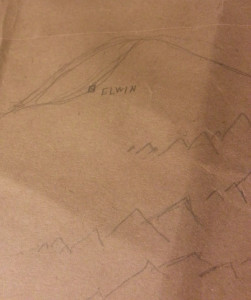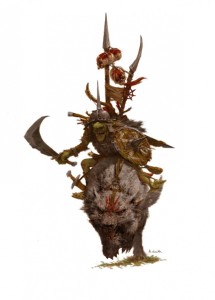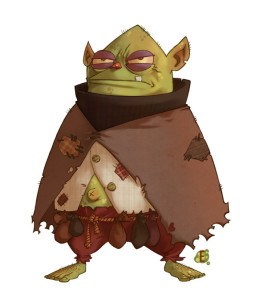Well THAT was fun! This was the first thought I had after running my very first Dungeon World game last night. The players seemed to really enjoy themselves, and in fact said as much after the game. We were smiling and laughing a lot.
The Setup
I started the game by placing out a small square map upon which I had drawn mountains in the South-Eastern corner. I explained that they were all from the same small town, and that this town (as well as others nearby) had decided to take back the mines (in the mountains) from Goblin raiders. A number of groups had been put together with the intent of striking various Goblin camps simultaneously, and theirs was one such group.
At this point, I said that some towns were closer to the mountains than others, and asked them, “what about your town?”. “Close”, they responded.
“And what is the name of your town?”, I asked.
The group looked at the Bard, who answered, “Elwin”.

These players were very new to roleplaying games, having only played a few games of Call of Cthulhu, so I thought presenting some options was a good way to start as opposed to leaving it wide open. I think they would have handled it okay in the end, but I didn’t want to overwhelm them initially.
It Begins

Fun Moments
There were a number of really fun moments during the game, but here’s a couple that stood out…
– The Bard using Bardic Lore to learn about the Worgs. They had come across some of them caged, and they were growling/howling, drawing attention to the PC’s. The ability allows the Bard to ask the GM any question about a creature/item/location, to which the GM must answer truthfully. The Bard said, “I heard a tale in a tavern once of something that can sooth these wild beasts – what was it?”. I answered that simply feeding them would work, so long as their master was not present. They all pulled out rations and began feeding the 5 caged Worgs, who ate quietly while they decided what to do.
– The Thief using her Trap Expert skill to check an area where the Rangers wolf had stopped (who was scouting ahead). She rolled an 8 (partial success) – she discovered a trip-wire, but I gave her two options regarding its disarming. It was a quiet moment where no one moved as she pondered the options… one was cutting the trip-wire and slowly releasing the pressure from the two ends, or 2, sticking her dagger into the area the trip-wire went into the wall, and moving over a small mechanism inside. I told her one would set off the trap, the other would disarm it – but she wasn’t sure which it was. I chose in my head which it would be, and she chose correctly… whew.
– The Ranger used a called shot to shoot the torch out of a Goblin’s hand, which worked out really well for their situation. The Ranger also had a number of great combat moments, a combination of fun narrative and great rolls.
The End

Some Conclusions
Reacting is More Involved
I pride myself on my improv skills, but this game does indeed push those skills. I’m very good at reacting quickly to players, and coming up with things off the cuff, but with Dungeon World there are (more often than not) mechanical decisions needing to be made as part of those responses. In D&D, the Fighter lunges at a Goblin with his spear and hits or misses. I will quickly describe the action, but do not need to account for anything mechanically until it is my turn to react. In Dungeon World however, describing the action not only needs to take into account how successful the Fighter was (10+ is success, 7-9 is success but at a cost), but additionally how that action leads to future danger for the Fighter. In some cases, you even need to present multiple options to the Fighter based on the success of the roll. Now don’t get me wrong, it is amazing fun the way this works, but it certainly is something (like many things) I will need some practice adjusting to. In some cases I surprised myself by coming up with really interesting options and responses, but other times I found myself disregarding the “cost” of a 7-9 result. I’ll do better next time!
Little Mistakes
Earlier in the day I had prepared as best I could, but of course mistakes were still made.
Beyond the challenge for me of reacting with a purpose and presenting good options for partial successes, things went very smoothly, but of course mistakes were still made. A few of them, for example…
– I mentioned it up front, but none of the players remembered to mark their XP when they rolled failures, I had even forgot by then.
– I allowed the Thief to throw daggers at two targets who were standing near each other at one point, which I think was fine, but the Thief continued from that point to attack two different mobs each time. I felt I needed to stop that, explaining that if there is a really epic moment where such an action can be described, it’s fine, but not otherwise.
– The Ranger didn’t realize (until the game was over) that his wolf could attack the Goblins.
Again, there were many minor mistakes made of which I am trying not to beat myself up about, but they were all items that will be resolved by simply reading over the rules again, especially now that we have played the game – many of those rules that seemed odd at the time will now make sense and these are things that just go along with playing a new game.
So Far, So Amazing
One of the things Dungeon World mentions frequently is that this is a game about adventure, and the action of said adventure. The idea is that your players will always be facing a challenge, and their lives of adventure are never boring – and things certainly played out this way. At one point, the Thief even said, “Geez, we never seem to get a break!”. The pace was always quick and always exciting. We played for 3 hours, and it never felt boring or slow.
There were a few moments where the action stopped for a bit (I did want to give them the opportunity to catch their breaths), and they used those to learn some helpful things about their environment. For example, during one small break in the action, the bard “Spouted Knowledge” and learned about paintings on the wall, and how they were indicators re: approaching rooms (“Dogs”, “Lookout” etc).
Overall we had a really good time. This was meant as a trial run, but the players indicated immediately that they wanted to play again, with the same characters. They were looking forward to getting back to town and accomplishing some things there. They were especially interested in the idea of helping flesh out the world setting itself through their actions, which was very cool to hear.

This sounds awesome, with some moments to learn from. Perfect! Pretty much mirrors my first experience. I will offer something regarding this comment:
“In some cases I surprised myself by coming up with really interesting options and responses, but other times I found myself disregarding the “cost” of a 7-9 result. I’ll do better next time!”
On the first statement, great job! This is where DW shines, are prodding us to be creative and use our imaginations. With regard to the second part, I’ve had great luck actually asking my players. They roll a 7-9 and I say, “uh oh, what just happened?” In some cases, I go with exactly what they say, but add some mechanics to it. In other cases, I may say something like “oh oh oh! Yes, it was like that but….” and then I add the downside or tweak it just a bit. This way, the players imaginations can fuel the failures too. But really, it’s just to take some of the load off you as the DM if you’re having a hard time visualizing the fiction.
Keep up the great work and I can’t wait to read about your next session!
Great idea, Mike! I’m running my first DW game this weekend, online, at ConTessa. I’m looking forward to asking the players “what do you think happens next?” when I’m out of ideas. I think the weakness in DW is that, when a GM gets fatigued, it’s hard to keep the endless font of ideas flowing.